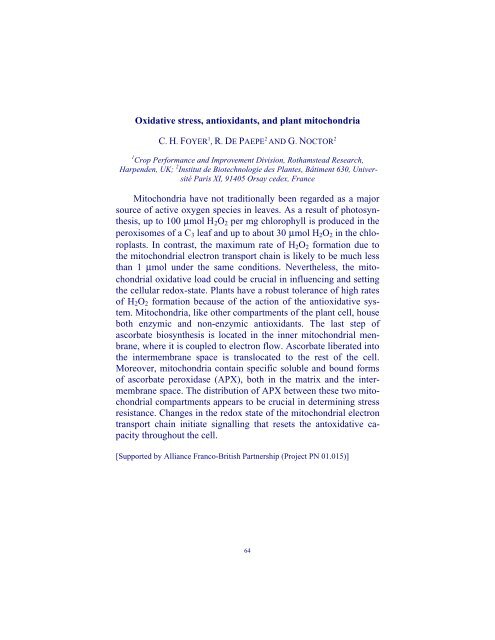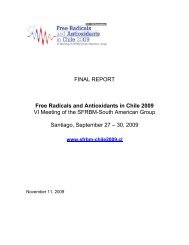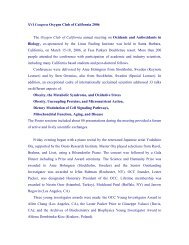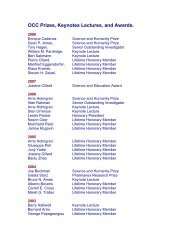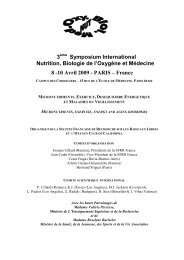oxidants and antioxidants in biology - Oxygen Club of California
oxidants and antioxidants in biology - Oxygen Club of California
oxidants and antioxidants in biology - Oxygen Club of California
Create successful ePaper yourself
Turn your PDF publications into a flip-book with our unique Google optimized e-Paper software.
Oxidative stress, anti<strong>oxidants</strong>, <strong>and</strong> plant mitochondria<br />
C. H. FOYER 1 , R. DE PAEPE 2 AND G. NOCTOR 2<br />
1 Crop Performance <strong>and</strong> Improvement Division, Rothamstead Research,<br />
Harpenden, UK; 2 Institut de Biotechnologie des Plantes, Bâtiment 630, Université<br />
Paris XI, 91405 Orsay cedex, France<br />
Mitochondria have not traditionally been regarded as a major<br />
source <strong>of</strong> active oxygen species <strong>in</strong> leaves. As a result <strong>of</strong> photosynthesis,<br />
up to 100 µmol H 2 O 2 per mg chlorophyll is produced <strong>in</strong> the<br />
peroxisomes <strong>of</strong> a C 3 leaf <strong>and</strong> up to about 30 µmol H 2 O 2 <strong>in</strong> the chloroplasts.<br />
In contrast, the maximum rate <strong>of</strong> H 2 O 2 formation due to<br />
the mitochondrial electron transport cha<strong>in</strong> is likely to be much less<br />
than 1 µmol under the same conditions. Nevertheless, the mitochondrial<br />
oxidative load could be crucial <strong>in</strong> <strong>in</strong>fluenc<strong>in</strong>g <strong>and</strong> sett<strong>in</strong>g<br />
the cellular redox-state. Plants have a robust tolerance <strong>of</strong> high rates<br />
<strong>of</strong> H 2 O 2 formation because <strong>of</strong> the action <strong>of</strong> the antioxidative system.<br />
Mitochondria, like other compartments <strong>of</strong> the plant cell, house<br />
both enzymic <strong>and</strong> non-enzymic anti<strong>oxidants</strong>. The last step <strong>of</strong><br />
ascorbate biosynthesis is located <strong>in</strong> the <strong>in</strong>ner mitochondrial menbrane,<br />
where it is coupled to electron flow. Ascorbate liberated <strong>in</strong>to<br />
the <strong>in</strong>termembrane space is translocated to the rest <strong>of</strong> the cell.<br />
Moreover, mitochondria conta<strong>in</strong> specific soluble <strong>and</strong> bound forms<br />
<strong>of</strong> ascorbate peroxidase (APX), both <strong>in</strong> the matrix <strong>and</strong> the <strong>in</strong>termembrane<br />
space. The distribution <strong>of</strong> APX between these two mitochondrial<br />
compartments appears to be crucial <strong>in</strong> determ<strong>in</strong><strong>in</strong>g stress<br />
resistance. Changes <strong>in</strong> the redox state <strong>of</strong> the mitochondrial electron<br />
transport cha<strong>in</strong> <strong>in</strong>itiate signall<strong>in</strong>g that resets the antoxidative capacity<br />
throughout the cell.<br />
[Supported by Alliance Franco-British Partnership (Project PN 01.015)]<br />
64


